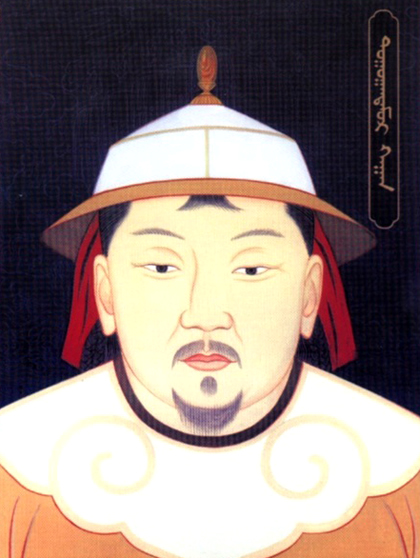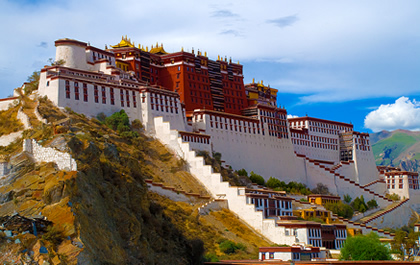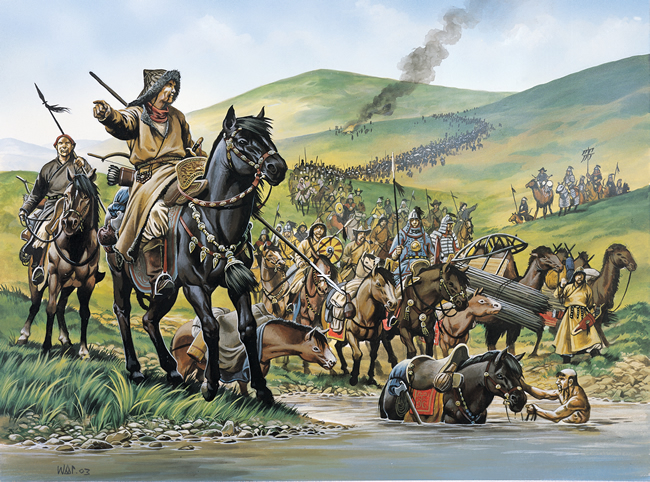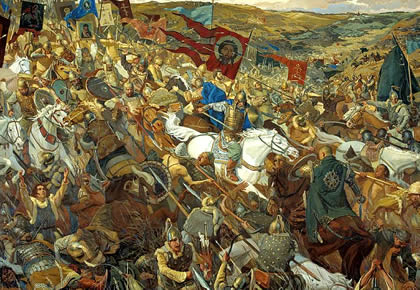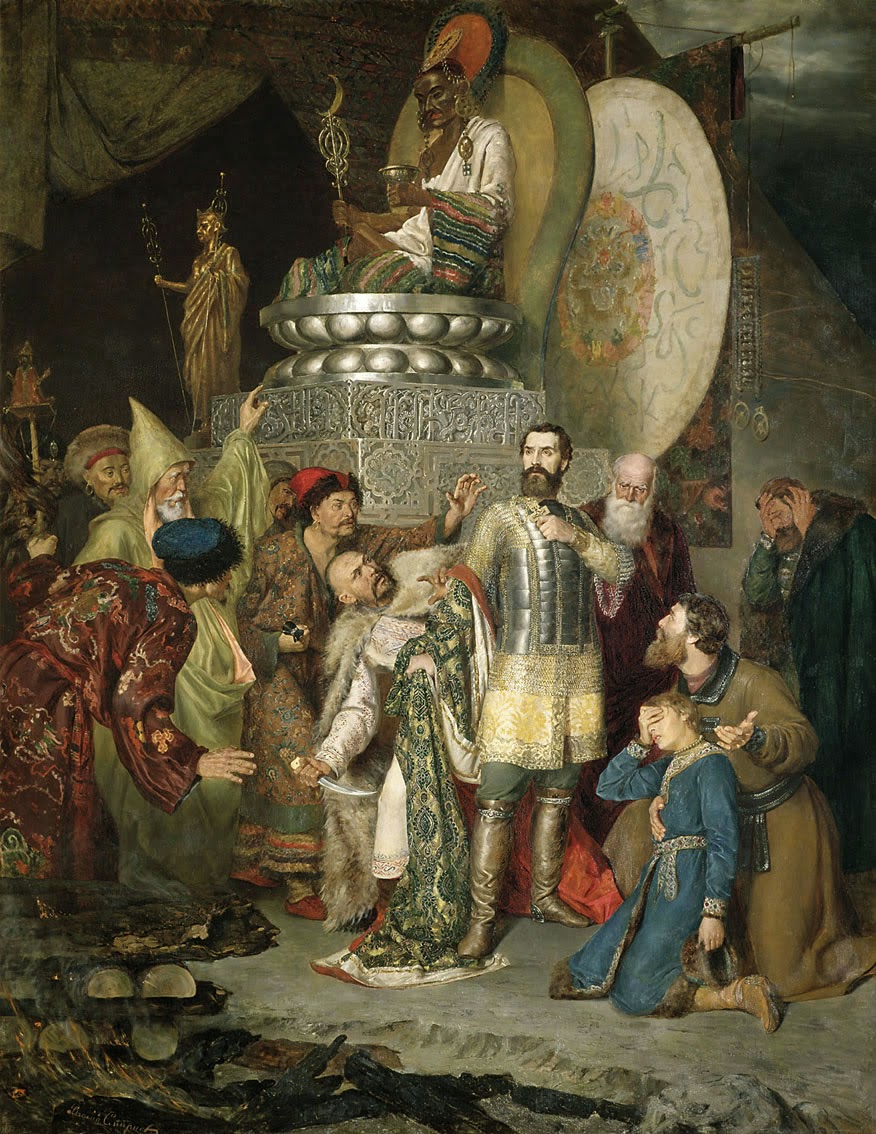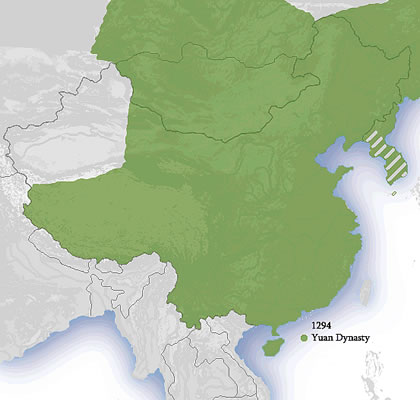 |
| Yuan Dynasty area in 1294 |
Yuan was the first non-Chinese dynasty to rule the entire area of the Chinese civilization (1279–1368). Kubilai Khan (grandson of Genghis Khan) proclaimed this rule in 1271, but because South China was not then under his control, historians did not formally recognize it as the ruling dynasty of China until the Southern Song (Sung) dynasty was destroyed in 1279.
Up to this time all dynasties had taken the name of the geographic region of its founder’s family. Since Mongolia was not part of China culturally, Kubilai chose Yuan (Great Originator), a word from the Chinese classic the Book of Changes.
Kubilai Khan (r. 1260–94) was the fifth grand khan of the Mongol empire, but his election was disputed and despite victory over his challengers, his leadership was never fully recognized, and he spent years fighting wars with his kinsmen.
 |
Kubilai Khan, the greatest Yuan ruler, fought wars to enlarge his empire, unsuccessfully only against Japan and Java. He and his successors ruled directly over Mongolia, China (including Manchuria and Tibet), and indirectly over vassal states that included Korea, Burma, Siam, Annam (North Vietnam), and Champa (South Vietnam).
Mongol Caste System and Social Organization
Although Kubilai had a much greater appreciation of Chinese culture than his predecessors and many of his contemporaries in the clan of Genghis Khan, he did not read or write Chinese. Even though his conquest of Southern Song did not feature the wholesale massacres practiced by his predecessors, his regime was nevertheless one of military occupation with Mongols the chief beneficiaries.
The Mongol government divided the people into four castes or categories as follows: The first caste were Mongols, who enjoyed the highest positions and most privileges. The second caste were called se-mu (light-eyed) people, who were Middle Easterners, and other non-Chinese including Europeans such as Marco Polo.
 |
| Kubilai Khan |
The third caste were northern Chinese and assimilated nomads, and the fourth and lowest were southern Chinese from the conquered Southern Song lands (who were the most numerous group).
The Mongol rulers trusted their non-Chinese subjects precisely because they were not Chinese and were therefore unconditionally loyal; many served the Mongol masters as ruthless tax collectors and moneylenders. The most numerous group, the southern Chinese, were most distrusted and exploited.
Mongols strenuously resisted assimilation to Chinese culture. Many preferred to live in yurts (tents), even in the capital palace grounds, and trekked to Mongolia to hunt annually. Their love of hunting and riding resulted in huge areas throughout China being turned into pastures and hunting parks, their previous owners being evicted or enslaved.
Mongol cuisine consisted mainly of boiled or roasted mutton, washed down with huge quantities of koumiss (fermented mare’s milk). Alcoholism killed many in the ruling house prematurely.
The fate of the Yuan dynasty was closely tied to the effectiveness of its military. Mongols and their nomadic allies formed the elite cavalry, which was supported by land granted to the hereditary heads of the units. But because Mongols lacked managerial skills and abused the Chinese farmers, many fled, causing a drop in production, hence income.
Chinese formed the infantry units, which were distrusted; for example, Chinese units had to turn in their weapons after maneuvers. As Mongol military effectiveness declined, the accumulated grievances of the subject people led to widespread rebellions.
The official language of the Yuan government was Mongolian. A written script had been created for writing down spoken Mongol under Genghis Khan; it used the Uighur script. Early Mongols practiced shamanism, but Kubilai Khan became interested in Chan (Ch’an) Buddhism in his youth and then turned to Tibetan Lamaist Buddhism after he took over Tibet and came under the influence of a religious leader called Phagspa. Phagspa was called on to create a new script for writing Mongol, called the Phagspa script, which is still in use.
Kubilai’s adherence and patronage also led to the conversion of Mongols in Mongolia and China to become Buddhists of the Tibetan school. Kubilai and his successors also granted enormous favors and huge sums to Tibetan clergymen, who became widely hated by the Chinese for their abuse of power.
Kubilai and his successors gradually allowed their Chinese subjects to add Chinese-style government offices, modified from the Tang (T’ang) and Song model, though under Mongol supervision.
In 1315 the examination system was even reinstated, but with a quota system that gave half of the doctoral degrees to Mongol and se-mu candidates regardless of qualification; the number of officials who had passed the examinations never exceeded 4 percent.
Chinese were restricted to low, mainly clerical posts and received few promotions. For committing the same crimes, Chinese were punished more severely, and Mongols were given light punishment for crimes against Chinese.
Some of Kubilai Khan’s successors patronized Chinese arts and culture, became collectors of Chinese art, and endorsed the writing of the official histories of all three preceding dynasties, the Song, Liao, and Jin, as the Yuan’s legitimate predecessors. However, by and large the Mongols left Chinese intellectual life alone.
This allowed private academies to continue teaching Neo-Confucianism. A number of notable painters also continued along earlier traditions. Because few intellectuals found opportunities under the Yuan government, some took up unorthodox professions such as medicine, fortune telling, writing fiction, and developing operatic drama.
Economic Recovery and The Luxury Trade
Kubilai Khan began measures to restore aspects of the damaged economy and fostered trade. Thus he had the Grand Canal repaired and built and maintained roads. These measures were necessary to transport food and luxuries from southern China to supply his court in Dadu (T’a-tu), which had been capital city of the Liao dynasty and Jin (Chin) dynasty, which had been destroyed by earlier Mongol armies and he had rebuilt.
He also maintained a second capital, his headquarters from the days before becoming emperor. It was called Shangdu (Shang-tu), located 200 miles north of Dadu and close to the Mongolian steppes.
The annual trek of the court from one capital to the other, which was continued throughout the dynasty, was costly. Kubilai also established a postal service with 1,400 stations, 4,000 carts, 6,000 boats, and 50,000 horses.
The international luxury trade prospered because the different branches of Genghis Khan’s family ruled from Korea to eastern Europe and imposed conditions that made travel and trade safe—historians call this the Pax Tatarica (Tatar Peace).
For example Chinese porcelain makers produced beautiful underglazed blue wares from the fine cobalt that was mined in Persia (Persia was ruled by the descendants of Kubilai Khan’s younger brother Hulagu Khan).
Sorghum, a new crop, was introduced and became an important food source for North China. However the prosperity under the Yuan government was spotty and largely superficial. Ineptitude and rampant inflation from fiscal irresponsibility and currency manipulation caused great harm to the economy and general impoverishment. Mongol and se-mu owned vast tracts of land, granted as appanage (fief) by Mongol rulers to their favorites, and reduced the people who worked for them to slavery.
Decline and Collapse
 |
| emblem of Mongolia |
Two were murdered while on the throne. Furthermore each change in ruler also resulted in bloody purges and policy reversals. Many of the disputes involved ethnic policy, whether to remain true to the nomadic heritage versus Sinicization, and relationship with the Chinese. Most of the short-reigning emperors were weak; several of them were children.
Toghon Temur Khan (r. 1333–68) was the last and longest reigning Mongol emperor, who assumed the throne at age 13. He was dogged throughout his reign by his disputed paternity, which cast doubt on his legitimacy. He relied on powerful ministers, the first of whom was called Bayan.
Bayan was anti-Chinese and sought to reassert Mongol authority by imposing strict segregation between Mongols and Chinese. He forbade Chinese to learn Mongol; confiscated their weapons, iron tools, and horses, in an attempt to forestall revolts; and forbade the performance of Chinese operas.
Finally he proposed solving the ethnic masalah by killing all Chinese with the five most popular surnames; that would have accounted for 90 percent of the population. Luckily by then the government had no ability to carry it out.
Floods, droughts, and plagues (possibly the Black Death brought to China by Mongol garrisons in the Middle East) overwhelmed the crumbling administration. Toghon Temur abandoned participation in the government, giving himself over to Lama Buddhist practices and debauchery.
In 1368 a successful Chinese rebel leader, Zhu Yuanzhang (Chu Yuan-chang), who had already established his headquarters and an administration in Nanjing (Nanking) south of the Yangzi (Yangtze) River, took Dadu. Before that Toghon Temur and his remaining court had fled to Mongolia, where he died two years later. Zhu became the founding emperor of the Ming dynasty.


